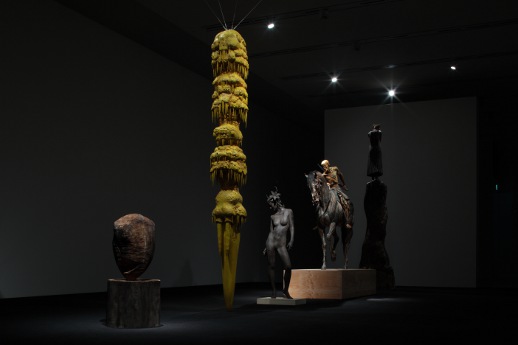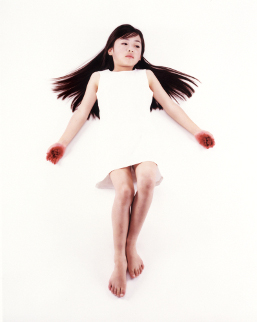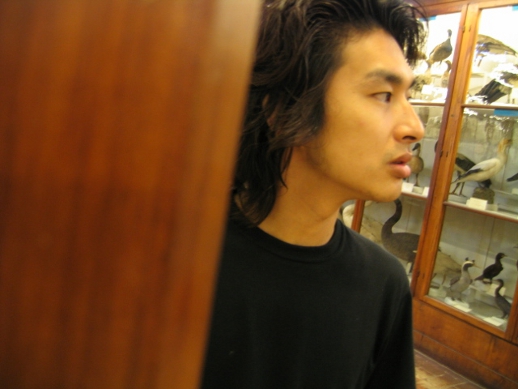Primitive Sculptor
Motohiko Odani thought he was late when he arrived to meet me at the entrance to his basement studio in Uguisudani, east Tokyo. Wearing his trademark leather jacket, he handed me a welcome can of coffee and apologized, though in fact he was on time.
Once inside any signs of sheepishness immediately disappeared as we quickly settled down to discuss his new exhibition, “Phantom Limb”, currently at the Mori Art Museum.
You are the youngest artist to have a solo show at the Mori Art Museum. Has this success surprised you?
I was surprised when the offer came! Mori is different to other art museums in Tokyo. The audience is totally different. There are lots of ordinary people, at any rate people who don’t go usually to art museums. It also has a higher profile than other museums so beforehand I could feel the pressure on me.
What was it like working in the Mori space?
I’ve never liked galleries with low ceilings. This is of course the norm in Japan but it makes some things harder to do. The art works and the viewing process become smaller and this bothers me. In terms of size Mori was much easier to work in.
What was the thinking behind the theme and title of the exhibition?
Probably many of the visitors have not heard of me before so it was important to divide the exhibition into clear sections, and to choose a title that made the works and the connection between them easier to understand from the very start of the show. And from now I think “Phantom Limb” can almost be a keyword to describe what I do.

The title work is a 1997 series of photographs of a girl holding out her hands in an almost crucifixion-style motif.
That wasn’t my intention. According to Jung it’s a pose we often revert to. But I’m interested in anatomical diagrams and it’s an image of that, not religious or about pain.
 There is so much about myth and sensations in your work. So is it kind of anthropology what you are doing? Investigating the primitive?
There is so much about myth and sensations in your work. So is it kind of anthropology what you are doing? Investigating the primitive?
Japanese artists tend to the phenomenological but my interest is more in cognitive science. For example, humans are programmed at a DNA level. I recently read in an article that the fear of snakes is part of this DNA, base level. I think of the concept of sculpture as highly primitive. Even contemporary sculpture connects to this so we have to be conscious of it. I’m very interested in primitive people.
Adjectives that are often applied to your sculptures include ‘gothic’ and ‘grotesque’. People tend to see an ambiguous mingling of beauty and death.
I don’t really think of my work as grotesque actually. Most people think ‘grotesque’ has a gloomy meaning. But the concept of beauty changes in different environments; so does the concept of grotesque. You could call what I am doing when I make an art work the same as the dancing courtship rituals between birds. It’s natural and beautiful but also gaudy. That kind of contrast is very important.
Previously you have cited Futurism and Umberto Boccioni as influences on your work. Is this still the case?
Yes, I am very interested in their concept of inner energy and speed, which is always pushing outwards. I can sympathize with their explorations of the possibilities of sculpture. Boccioni ironically said that sculpture was ‘boring’ but even so, or even because of this there were possibilities in sculpture.

There is prevalence among contemporary Japanese artists to create elaborate works that are very impressive at the surface level. Putting aside individual merits, it seems to me there is a great danger that viewers of these kinds of works will merely be dazzled by the intricacy of the construction and this may override or substitute for actually considering the work and its message itself. Do you ever worry about this?
I think this is both Japanese artists’ strength but also their weakness. Yes, the response of being impressed by the details is different to looking properly at the work itself. I think we have reached the point of it being dangerous. It might be something characteristic to Japanese. By becoming too technical, there is a danger that art is not an open expression but just self-expression. In my opinion, craft-like works are just one type of method or material, and I think it’s important to see a layer of a conceptual or historical context against that background.
“Phantom Limb” runs until February 27. TABlog also published a review of the exhibition.
William Andrews
William Andrews



